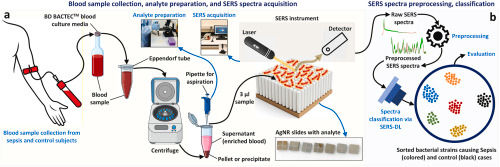A New Way to Sensitively Detect Bacteria Infections
- Yiping Zhao
- Jul 15, 2021
- 1 min read
In a recent publication co-authored by Prof. Yiping Zhao from the Department of Physics and Astronomy at the University of Georgia, a new and high sensitive method is demonstrated to detect bacteria infection in biofluid. This method is using bacterial endotoxins as biomarkers to identify the bacteria infections. The bacterial endotoxins are major components of Gram-negative bacterial outer membrane leaflets and are lipopolysaccharides (LPSs) that are constantly shed from bacteria during growth and infection. This publication shows, for the first time, that unique surface-enhanced Raman scattering (SERS) spectra of enteric LPSs from E. coli, S. typhimurium, S. minnesota, V. cholerae, Rhizobium species R. CE3, and R. NGR, as well as Neisseria meningitidis endotoxin structures, LPSs, lipid A, and KDO2-lipid A,

can be obtained. The characteristic peaks of the SERS spectra reveal that most of the tested LPS structures are from lipids and saccharides, i.e., the major components of LPSs, and these spectra can be successfully used to differentiate between endotoxins with principal components analysis. In addition, all the LPS samples here are measured at a concentration of 10 nmole/mL, which corresponds to their relevant pathophysiological concentrations in clinical infections. This study is a result of international collaboration among US, China, and Qatar. The other two authors are Prof. Xiaomeng Wu from China Agricultural University and Prof. Susu M. Zughaier from Qatar University.
A full version of the publication can be found at https://www.mdpi.com/2079-6374/11/7/234.





Comments